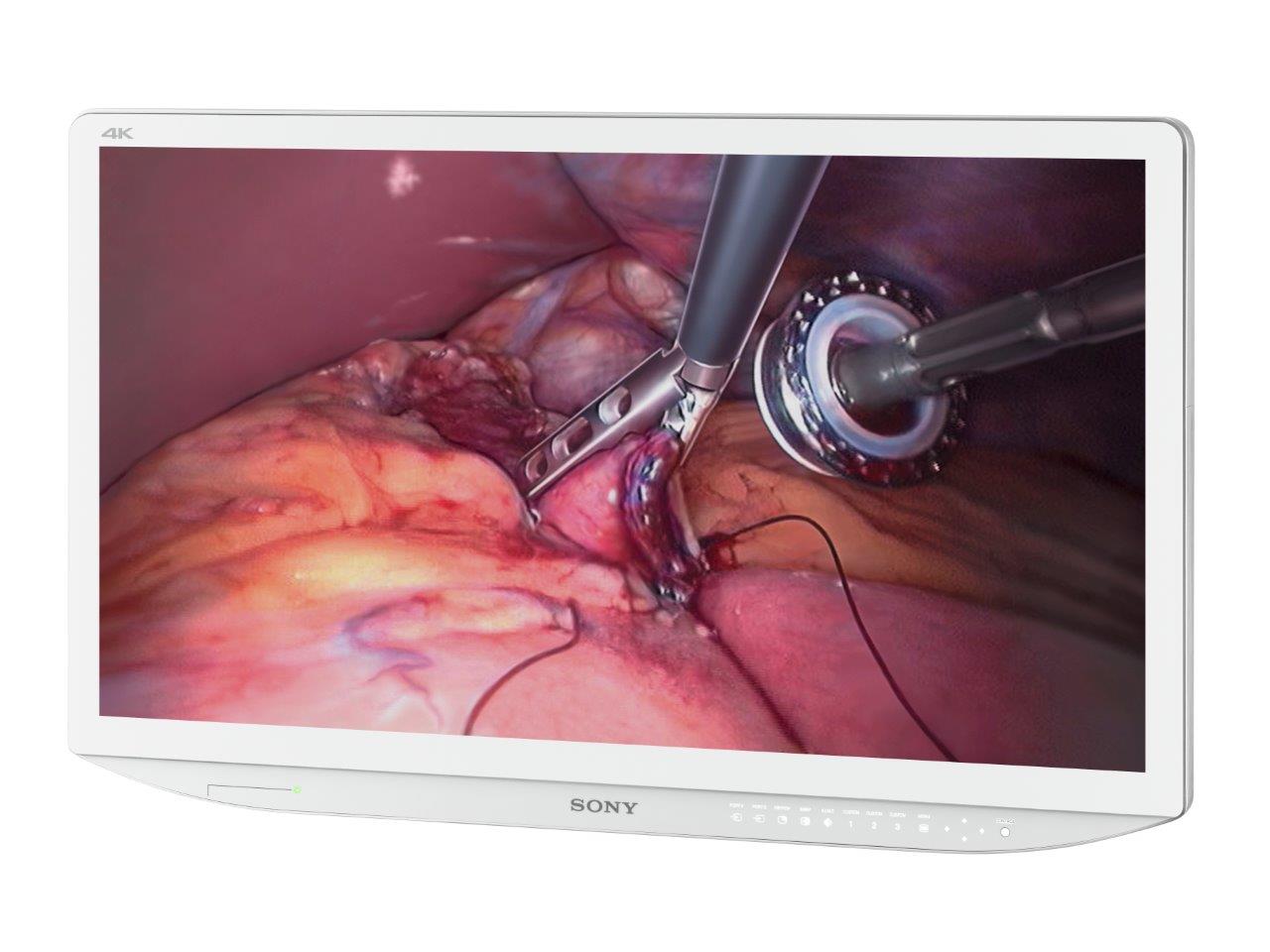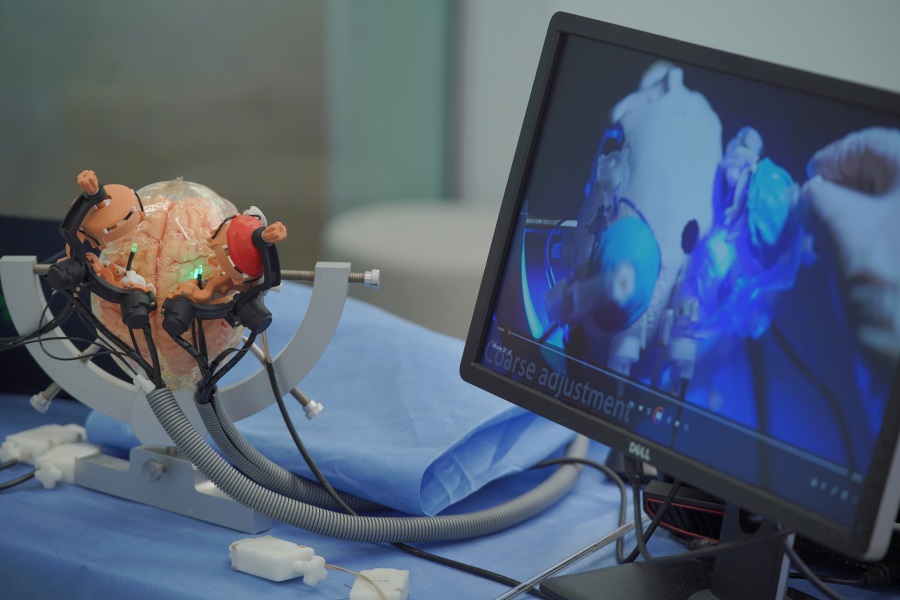New Monitors Bring 4K to the Medical Industry
|
By HospiMedica International staff writers Posted on 25 Oct 2015 |

Image: The Sony 55-inch 4K monitor (Photo courtesy of Sony).
Two new 4K medical-grade monitors provide unparalleled clarity, resolution, and detail during surgical procedures, making them ideal for hospitals, surgical centers, clinics, and other medical facilities.
The Sony (Tokyo, Japan) 31-inch (LMD-X310MD) and 55-inch (LMD-X550MD) 4K monitors feature a unique slender chassis and front bezel to provide edge-to-edge screen protection and corner-to-corner uniformity, while reducing glare and reflection. An added feature, OptiContrast technology, replaces the layer of air between the panel and the glass with a layer of resin specially formulated to match the refractive properties of the glass; this helps establish dark backgrounds for high-contrast images, even in brightly lit rooms. It also reduces glare and reflection and helps eliminate internal dew condensation.
The monitors feature an extremely wide gamut of colors which results in higher contrast and more accurate color reproduction. Both models offer Quad view picture display, so surgeons can see four full high definition(HD, 1920 x 1080) images at the same time. Users can also select different display modes, including Mirror Image, Side-by-Side, Picture-in-Picture (PIP), and Picture-out-Picture. Zoom control allows enlarging a 4K image without experiencing the pixilation normally associated with lower resolution technologies.
Images can also be adjusted using the advanced image multiple enhancer (AIME), a technology that lets users enhance structure and color for more comfortable viewing. A field-programmable gate array (FPGA) board improves visibility and features in four contrast and eight color modes. Sony is also developing of a line of 4K products to create compatibility among visualization technologies and other devices in the medical workflow, including a 4K medical grade recorder, a 4K video over IP converter, and a content management system that will allow surgeons to store, access and share 4K and HD video, still images, and documents with easy access to them throughout a hospital network.
“4K provides the highest resolution available today for surgery, giving physicians and their teams advanced visualization with virtually no pixilation, especially during up-close viewing,” said Julie Holodak, senior marketing manager at Sony’s Medical Systems Division. “4K technology gives a better view of general anatomy and blood vessels, allowing nurses, clinicians, and surgeons to see in far more detail than even possible with HD. This is important for minimally invasive and general surgery procedures, and for more immersive education and training.”
The increased number of pixels in a 4K image provides a sharper, more detailed image with four times the resolution of HD, resulting in enhanced clarity, higher contrast, and more accurate color reproduction.
Related Links:
Sony
The Sony (Tokyo, Japan) 31-inch (LMD-X310MD) and 55-inch (LMD-X550MD) 4K monitors feature a unique slender chassis and front bezel to provide edge-to-edge screen protection and corner-to-corner uniformity, while reducing glare and reflection. An added feature, OptiContrast technology, replaces the layer of air between the panel and the glass with a layer of resin specially formulated to match the refractive properties of the glass; this helps establish dark backgrounds for high-contrast images, even in brightly lit rooms. It also reduces glare and reflection and helps eliminate internal dew condensation.
The monitors feature an extremely wide gamut of colors which results in higher contrast and more accurate color reproduction. Both models offer Quad view picture display, so surgeons can see four full high definition(HD, 1920 x 1080) images at the same time. Users can also select different display modes, including Mirror Image, Side-by-Side, Picture-in-Picture (PIP), and Picture-out-Picture. Zoom control allows enlarging a 4K image without experiencing the pixilation normally associated with lower resolution technologies.
Images can also be adjusted using the advanced image multiple enhancer (AIME), a technology that lets users enhance structure and color for more comfortable viewing. A field-programmable gate array (FPGA) board improves visibility and features in four contrast and eight color modes. Sony is also developing of a line of 4K products to create compatibility among visualization technologies and other devices in the medical workflow, including a 4K medical grade recorder, a 4K video over IP converter, and a content management system that will allow surgeons to store, access and share 4K and HD video, still images, and documents with easy access to them throughout a hospital network.
“4K provides the highest resolution available today for surgery, giving physicians and their teams advanced visualization with virtually no pixilation, especially during up-close viewing,” said Julie Holodak, senior marketing manager at Sony’s Medical Systems Division. “4K technology gives a better view of general anatomy and blood vessels, allowing nurses, clinicians, and surgeons to see in far more detail than even possible with HD. This is important for minimally invasive and general surgery procedures, and for more immersive education and training.”
The increased number of pixels in a 4K image provides a sharper, more detailed image with four times the resolution of HD, resulting in enhanced clarity, higher contrast, and more accurate color reproduction.
Related Links:
Sony
Latest Health IT News
- Machine Learning Model Improves Mortality Risk Prediction for Cardiac Surgery Patients
- Strategic Collaboration to Develop and Integrate Generative AI into Healthcare
- AI-Enabled Operating Rooms Solution Helps Hospitals Maximize Utilization and Unlock Capacity
- AI Predicts Pancreatic Cancer Three Years before Diagnosis from Patients’ Medical Records
- First Fully Autonomous Generative AI Personalized Medical Authorizations System Reduces Care Delay
- Electronic Health Records May Be Key to Improving Patient Care, Study Finds
- AI Trained for Specific Vocal Biomarkers Could Accurately Predict Coronary Artery Disease
- First-Ever AI Test for Early Diagnosis of Alzheimer’s to Be Expanded to Diagnosis of Parkinson’s Disease
- New Self-Learning AI-Based Algorithm Reads Electrocardiograms to Spot Unseen Signs of Heart Failure
- Autonomous Robot Performs COVID-19 Nasal Swab Tests

- Statistical Tool Predicts COVID-19 Peaks Worldwide
- Wireless-Controlled Soft Neural Implant Stimulates Brain Cells
- Tiny Polymer Stent Could Treat Pediatric Urethral Strictures
- Human Torso Simulator Helps Design Brace Innovations
- 3D Bioprinting Rebuilds the Human Heart
Channels
Artificial Intelligence
view channel
AI-Powered Algorithm to Revolutionize Detection of Atrial Fibrillation
Atrial fibrillation (AFib), a condition characterized by an irregular and often rapid heart rate, is linked to increased risks of stroke and heart failure. This is because the irregular heartbeat in AFib... Read more
AI Diagnostic Tool Accurately Detects Valvular Disorders Often Missed by Doctors
Doctors generally use stethoscopes to listen for the characteristic lub-dub sounds made by heart valves opening and closing. They also listen for less prominent sounds that indicate problems with these valves.... Read moreCritical Care
view channel
AI Doubles Medical Professionals’ Accuracy in Reading EEG Charts of ICU Patients
Electroencephalography (EEG) readings are crucial for detecting when unconscious patients may be experiencing or are at risk of seizures. EEGs involve placing small sensors on the scalp to measure the... Read moreFlexible Device Enables Sweat Gland Stimulation and Simultaneous Biosensing
Human sweat is rich in biomarkers that can be used to monitor a range of health conditions, from diabetes to genetic disorders. Many users prefer sweat sampling over blood collection because it is painless.... Read more
WHO Publishes First Global Guidelines to Reduce Bloodstream Infections from Catheter Use
Up to 70% of all inpatients require a catheter, specifically a peripherally inserted catheter (PIVC), at some point during their hospital stay. Patients who receive treatments via catheters are particularly... Read moreSurgical Techniques
view channel
Study Warns Against Dangerous Smoke Levels Produced During Endoscopic Gastrointestinal Procedures
Healthcare professionals involved in certain smoke-generating endoscopic gastrointestinal procedures, such as those using electrical current to excise polyps, may be exposed to toxin levels comparable... Read more
New Hydrogel Sealant Effective at Sealing Dural Defects and Preventing Postoperative Adhesion
The dura mater is a fibrous membrane of connective tissue that envelops the brain and spinal cord. In neurosurgical procedures that require access to the brain or spinal cord, opening the dura mater often... Read more
MRI-Guided Multi-Stage Robotic Positioner Enhances Stereotactic Neurosurgery Precision
Magnetic resonance imaging (MRI) offers significant benefits in neurosurgery, providing detailed 3D visualizations of neurovascular structures and tumors. Traditionally, its use has been restricted to... Read morePatient Care
view channelFirst-Of-Its-Kind Portable Germicidal Light Technology Disinfects High-Touch Clinical Surfaces in Seconds
Reducing healthcare-acquired infections (HAIs) remains a pressing issue within global healthcare systems. In the United States alone, 1.7 million patients contract HAIs annually, leading to approximately... Read more
Surgical Capacity Optimization Solution Helps Hospitals Boost OR Utilization
An innovative solution has the capability to transform surgical capacity utilization by targeting the root cause of surgical block time inefficiencies. Fujitsu Limited’s (Tokyo, Japan) Surgical Capacity... Read more
Game-Changing Innovation in Surgical Instrument Sterilization Significantly Improves OR Throughput
A groundbreaking innovation enables hospitals to significantly improve instrument processing time and throughput in operating rooms (ORs) and sterile processing departments. Turbett Surgical, Inc.... Read moreHealth IT
view channel
Machine Learning Model Improves Mortality Risk Prediction for Cardiac Surgery Patients
Machine learning algorithms have been deployed to create predictive models in various medical fields, with some demonstrating improved outcomes compared to their standard-of-care counterparts.... Read more
Strategic Collaboration to Develop and Integrate Generative AI into Healthcare
Top industry experts have underscored the immediate requirement for healthcare systems and hospitals to respond to severe cost and margin pressures. Close to half of U.S. hospitals ended 2022 in the red... Read more
AI-Enabled Operating Rooms Solution Helps Hospitals Maximize Utilization and Unlock Capacity
For healthcare organizations, optimizing operating room (OR) utilization during prime time hours is a complex challenge. Surgeons and clinics face difficulties in finding available slots for booking cases,... Read more
AI Predicts Pancreatic Cancer Three Years before Diagnosis from Patients’ Medical Records
Screening for common cancers like breast, cervix, and prostate cancer relies on relatively simple and highly effective techniques, such as mammograms, Pap smears, and blood tests. These methods have revolutionized... Read morePoint of Care
view channel
POCT for Infectious Diseases Delivers Laboratory Equivalent Pathology Results
On-site pathology tests for infectious diseases in rural and remote locations can achieve the same level of reliability and accuracy as those conducted in hospital laboratories, a recent study suggests.... Read more
Cartridge-Based Hemostasis Analyzer System Enables Faster Coagulation Testing
Quickly assessing a patient's total hemostasis status can be critical to influencing clinical outcomes and using blood products. Haemonetics Corporation (Boston, MA, USA) has now obtained 510(k) clearance... Read more
Critical Bleeding Management System to Help Hospitals Further Standardize Viscoelastic Testing
Surgical procedures are often accompanied by significant blood loss and the subsequent high likelihood of the need for allogeneic blood transfusions. These transfusions, while critical, are linked to various... Read moreBusiness
view channel
MEDICA INNOVATION FORUM for the Healthcare Innovations of the Future
By always offering innovations and updating existing program formats, the internationally leading medical trade fair MEDICA in Düsseldorf has been successful for over half a century and always gives its... Read more















